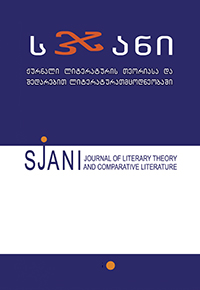დანტე, ჯოზეფ კონრადი და იოანეს გამოცხადება ტომას ელიოტის "კაცის ფიტულებში"
Dante, Joseph Conrad, and the Revelation of St. John
in T. S. Eliot's “The Hollow Men”
Author(s): Temur KobakhidzeSubject(s): Literary Texts
Published by: ლიტერატურის ინსტიტუტის გამომცემლობა
Keywords: Eliot; Dante; myth; hollow men.
Summary/Abstract: In European art and literature, symbolic representations of hell have always been infinitely diverse. Throughout the art and literary history, numerous poets, writers and artists have shown interest in the ‘infernal’ topic, and many of them have created some private and very personal ‘infernos’ of their own. The corresponding cultural image is exceptionally rich and overwhelmed with associations: infernal scenes of tortured sinners are pictured in grand facades of European Gothic cathedrals, and skillfully wrought dance macabre scenes are seen in their interior decorations, as are grinning sculls and skeletons, displayed in countless vaults and crypts, ancient engravings and illuminated manuscripts. Unlike T. S. Eliot in “The Hollow Men”, even the apogees of this gloomy genre like Hieronymus Bosch and Peter Brueghel the Elder are more tolerant, humane and colorful in representing their own infernal visions. The majority of tortured souls in Dante’s Inferno are affluently colored and artistically ‘alive’, some of them being full-scale dramatic characters, radiating a tragic sense of life. The resurrected souls of Michelangelo’s Last Judgment, notwithstanding its clearly religious subject, objectively praise the Renaissance Personality at its highest. Unlike all these, the hell of T. S. Eliot’s ‘cactus land’ is devoid of any vivid emotion, it is black-and-white and desperate in its monotony. Stuffed men are absolutely uniform. The author’s irony, which colored Eliot’s earlier poetry from Prufrock and Other Observations to Poems, 1920 and The Waste land is gone and never retrieved back in Eliot’s later poetry. In his densely populated longer poem, saturated with an abundance of literary and religious associations, Eliot radically transforms the traditional image of hell as a dark and torturous pit that has been universally applicable for centuries. Instead of picturing horrified souls in gloomy infernal caves, he depicts a seemingly simple yet complicated picture of both spiritual and physical paralysis of a society. In the world of “The Hollow Men” there is no room for a protagonist, a hero or an anti-hero. There is no drama, no collision, no conflict of characters of any kind. A bunch of paralyzed puppet-like whispering fi gurants, stuffed men resembling scarecrows, motionless, helpless, and colorless, are stuck in the soil of the ‘cactus land’. The trouble with the hollow men is their overwhelming mediocrity, their ‘hollowness’ in the manner of some of Conrad’s characters in Heart of Darkness, or their being ‘lukewarm’ like members of the Church of Laodiceans, described in the Book of Revelation. No author perhaps, before Eliot has portrayed a general image of such a horrifying dead end that results from the degradation of spiritual values, a blind alley of the overall moral disaster, completely devoid of any pathos and reduced to a helpless whimper.
Journal: სჯანი
- Issue Year: 2011
- Issue No: 12
- Page Range: 64-78
- Page Count: 15
- Language: Georgian

